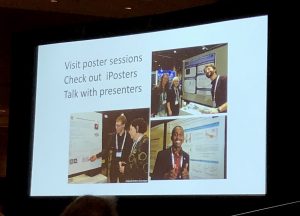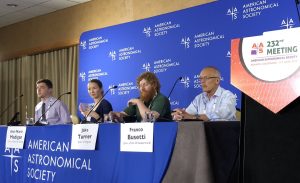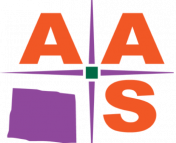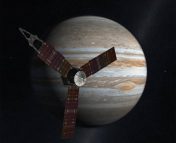Welcome to the summer American Astronomical Society (AAS) meeting in Denver, Colorado! Astrobites is attending the conference as usual, and we will report highlights from each day here. If you’d like to see more timely updates during the day, we encourage you to search the #aas232 hashtag on twitter. We’ll be posting once a day during the meeting, so be sure to visit the site often to catch all the news!
Sunday, 3 June
Using Python to Search NASA’s Astrophysics Archives (by Gourav Khullar)
The sessions for this AAS meeting began with a workshop on using python to parse NASA data archives, organized by Vandana Desai (IPAC/Caltech) and the team at NASA Astronomical Virtual Observatory (NAVO).
To quote the workshop organizers, “NASA missions have collected a huge amount of data spanning a large range in wavelengths. These data are housed in four different archives: the HEASARC, MAST, IRSA, NED…..The archives have been working together…to assemble the data you need to get your research done. We’ve done this by standardizing the way that programs can access the data we house. Since Python is a very popular programming language, we are going to use it to show you how you can take advantage of this standardization..”
Workshops notebooks and data at this URL:https://t.co/C151t66vS7#AAS232 https://t.co/wHUaS9rkHA
— IR Science Archive (@NASA_IRSA) June 3, 2018
how to do http for humans! https://t.co/vOaqIoSaJP Useful for python requests package for url queries! #aas232 @VanDesai
— Vanshree Bhalotia (@Vanshreee) June 3, 2018
The resources are available at the following link: “https://github.com/NASA-NAVO/aas_workshop_2018_summer”. We would like to encourage all our readers to start retrieving multi-wavelength information from these rich exquisite datasets!
Using Anchored Inquiry to Teach Astronomy and Physics (by Gourav Khullar)
This session, organized by Zoe Buck Bracey, PhD (BSCS Science Learning), focused around pedagogical techniques to be used in classrooms about concepts. This 4-hour workshop was full of mini-experiments, tasks and group work (along the ideas of “Think, Pair, Share!”), to encourage instructors towards building classes around concept “anchors”. The example studied throughout this amazing workshop attempted to teach the model of the Earth-Sun system and encourage understanding of seasons on our planet. We used average planetary temperature datasets as anchors, which allowed us participants to put student engagement at the forefront, encouraging students to come up with a model that explains why seasons occur. Throughout the activities, the emphasis was on students bringing prior knowledge into a class and how an instructor can enable them cross the bridge from having a partial idea of concepts to a complete understanding.
Absolutely! We talked about building concept lectures around "anchors" – examples or phenomena that bring student engagement to the center. E.g. A class about seasons on Earth could begin with analyzing temp patterns along latitudes and altitudes! pic.twitter.com/aU8S7I8K6i
— Gourav Khullar (@isskywalker) June 4, 2018
Monday, 4 June
Plenary Lecture: Welcome Address (by Susanna Kohler)
AAS President Christine Jones opened the day with a brief session welcoming attendees to this meeting and outlining some of the highlights that we can look forward to at AAS 232 in the coming week. She especially drew attention to the plenary sessions (don’t forget to check out our interviews with keynote speakers!), the town halls, and a few special sessions such as this morning’s AAS Taskforce on Diversity and Inclusion in Astronomy Graduate Education, which Gourav reported on below. She also pointed out the value of visiting posters and talking with presenters — we appreciated the photos of students presenting their work at past meetings!
Kavli Foundation Lecture: From Extrasolar Planets to Exo-Earths (by Susanna Kohler)
Dr. Debra Fischer (Yale University) kicked off the plenary talks of this meeting by giving the Kavli Foundation Plenary Lectureship, an invited talk on “recent research of great importance.” Fischer’s opening comment — “It’s tough to give a lecture on exoplanets these days, because I know there are so many experts in the audience!” — acknowledged the huge boom that exoplanet research has undergone since its inception. Fischer, however, is a highly qualified expert herself: she’s spent more than two decades in the field, developing techniques for detecting exoplanets.
Fischer: we’ve learned a lot about exoplanet population statistics. #aas232 pic.twitter.com/ou2H1rkPFE
— astrobites (@astrobites) June 4, 2018
Fischer gave a broad overview of the past and current state of exoplanetary studies, discussing the types of planets we’ve discovered and how we’ve found them. There are several approaches that have been used to discover and characterize the ~4,000 exoplanets known at this time:
- Transits, in which a dip in a star’s light reveals the presence of a planet passing in front of its host;
- Direct detection, in which exoplanets are actually imaged directly by telescopes;
- Gravitational microlensing, in which the planet is never seen, but its gravitational pull bends light from a background star in a telltale way, indicating the planet’s presence;
- Astrometry, in which the visible wobbling motion of a star reveals the gravitational tug of an orbiting planet; and
- Radial velocity, in which such a stellar wobble is seen in the star’s spectrum, as its spectral lines shift back and forth due to the approaching and receding star.
Fischer: distance matters! Different exoplanet detection techniques find exoplanets at different distances from earth. #aas232 pic.twitter.com/silCMDMESF
— astrobites (@astrobites) June 4, 2018
This last technique, radial velocity, is the approach that Fischer has been working to improve. Thus far, the smallest radial-velocity wobble we’ve been able to detect is around 1–2 m/s, or roughly walking speed; Fischer hopes that in the future we can push this precision down to just 10 cm/s, a signal akin to the wobble that Earth induces in the Sun. This requires remarkable advancements in both technology of spectrographs and modeling of things like contamination of stellar spectra by Earth’s atmosphere — but Fischer and other members of the field are making significant progress in these directions!
Fischer concluded by mentioning the many new and upcoming missions that will advance the field of exoplanet studies — like Gaia, TESS, CHEOPS, JWST, and WFIRST — and she threw in a sales pitch for the Large Ultraviolet/Optical/Infrared Surveyor (LUVOIR), a space telescope under consideration as a future NASA project. She also pointed out the broad community and general-public support of exoplanet science. The future of this field is bright!
You can check out Stephanie Hamilton’s interview of Fischer here.

A simulated view of the same part of the sky as observed by Hubble Space Telescope (left) vs. the proposed LUVOIR (right). [G. Snyder, STScI /M. Postman, STScI]
Press Conference: Minor Planets, Dwarf Planets & Exoplanets (by Susanna Kohler)

Artist’s rendering of the minor planet Sedna, a distant body in the outer solar system. [NASA/JPL-Caltech]
Next up, University of Virginia graduate student Jake Turner presented his and collaborators’ work in the search for exoplanets with magnetic fields. Magnetic fields are of interest in the context of exoplanets and habitability because they can protect their planets from stellar winds and help them to retain their atmospheres. Turner and collaborators hope to be able to use the Low-Frequency Array (LOFAR) to find exoplanet radio signals that would indicate the presence of magnetic fields. To improve their ability to extract such radio signals from background radio noise, the team simulated the expected signals using a real planetary signal — Jupiter’s radio waves, as seen by LOFAR. They hope to soon use these methods to discover magnetic fields of planets beyond our solar system. Press release
Intrigued by Tattooine? In the final presentation of the press conference, graduate student Franco Busetti (University of the Witwatersrand, South Africa) one-ups this sci-fi binary by discussing how planets might orbit around triple star systems. By running a series of orbital integrations — over 45,000 of them! — Busetti and collaborators showed that exoplanets can exist on stable orbits in substantial regions around triple systems. While only 40 or so planets have been found around triple systems thus far, we can hope that the Gaia and TESS missions will find many more.
AAS Taskforce on Diversity and Inclusion in Astronomy Graduate Education (by Gourav Khullar)
This AAS special session aimed to disseminate updates of the AAS Taskforce on Diversity and Inclusion to the membership. Kelle Cruz and Alex Rudolph began the proceedings with a description of the Taskforce, which was empaneled in November 2018, and is in the process of putting together a report on their findings via several of their initiatives.
A description of the Taskforce’s charge is as follows:
- To look into retention and recruitment practices along all axes of identity.
- To build consensus on evidence-based practices across the community.
- To create and collaborate on a statement of best practices.
- To develop guidelines that help astro grad programs towards implementation of suggestions coming out of the Taskforce initiatives.
- To develop recommendations for ongoing data collection from astro grad programs.
Surprising no one: 73% of AAS members are men. 84% of members are white. We’re no where close to where we should be. #AAS232 pic.twitter.com/nfgIrUU2lP
— Natalie Gosnell (@Nattie_G_) June 4, 2018
The Taskforce has 3 working groups:
- Recruiting & Admission
- Mentoring & Retention
- Data Collection & Dissemination
Some of the working-group recommendations were discussed, after which we broke out in smaller sessions for direct engagement with the working-group members:
Recruiting and admission
- Inclusive Astronomy & Nashville Recommendations were brought up (read more about this here: https://astrobites.org/2017/12/25/building-an-inclusive-astronomy-community/).
- Partnering with institutions producing PhD-ready under-represented minorities could go a long way in bringing diversity and representation to departments.
- There is a need for implementing evidence-based, holistic approaches to admissions.
- Coordinating with campus offices regarding fee waivers, fellowship opportunities, GRE policies, and application contents is a priority.
Mentoring and retention
- One of the priorities was facilitating an accessible and welcoming environment, ending harassment in and around astro workplaces, and supporting effective, evidence-based mentorship at all levels of astrophysics research.
- The working group is also involved in engaging departments in conversations, conducting assessments in your local environment, incentivizing professional development, taking actions, and monitoring progress on these actions.
Data Collection & Dissemination
- This working group’s priorities are built on baselines and progress in demographics and climate, as well as initiatives that provide accountability.
- There is a proposal to conduct climate surveys every 2 years, collect and report demographic data, and create a platform to collect data, analysis and decentralize information as soon as is feasible.
Kim Coble gives inclusive astronomy links during #AAS232 pic.twitter.com/tvWwyK9H9c
— Vanshree Bhalotia (@Vanshreee) June 4, 2018
Plenary Lecture: Heavy Element Synthesis in the Universe (by Kerry Hensley)
What do gold, krypton, plutonium, and europium have in common? They’re all r-process elements, of course! Elements heavier than iron form through neutron-capture processes; when an atom captures a free-roaming neutron, the neutron will often change into a proton by emitting a beta particle (an electron, in this case). This leads to atoms bulking up into heavier and heavier elements over time. There are two neutron-capture processes: rapid (r-process) and slow (s-process), where the speed refers to the rate of neutron capture compared to the rate of beta decay. While all elements heavier than iron can be formed through both pathways, some elements (like gold and europium) are almost exclusively formed through the r-process.
https://twitter.com/alexanderpji/status/1003707760645558272?ref_src=twsrc%5Etfw
In today’s lunchtime plenary, Dr. Enrico Ramirez-Ruiz (University of California, Santa Cruz) described the importance of understanding r-process nucleosynthesis in the universe. While the basic understanding of how heavy elements form has long been known, the details are still unclear — especially in terms of what astrophysical objects produce them and in what amounts. In this talk, Dr. Ramirez-Ruiz focused on neutron star mergers as a source of r-process elements. Although neutron star mergers are rare, each collision can produce about a Jupiter-mass worth of gold — equivalent to the gold abundance of a million stars!

R-process enrichment by Type II supernovae (left) and neutron star mergers (right). Cookies are now scientifically relevant! [brandeating.com and handletheheat.com]
This unevenness in heavy-element production helps to explain the huge variation in europium abundance (europium is almost exclusively made through the r-process) relative to iron in old stars. While we still need to know more about how heavy elements get mixed throughout a galaxy, studying and modeling neutron star mergers can help us understand the origins of very heavy elements in the universe.
Be sure to check out Mia de los Reyes’ interview with Dr. Ramirez-Ruiz here!
Plenary Lecture: The Relationship Between Galaxies and the Large-Scale Structure of the Universe (Mia de los Reyes, Mara Zimmerman, and Gourav Khullar)
Another plenary! Alison Coil presenting on the relationship between galaxies and large-scale structure. Introduction includes a plug for her inclusion work in faculty recruitment and hiring at UCSD. #AAS232 pic.twitter.com/eJWKdzQFU7
— Natalie Gosnell (@Nattie_G_) June 4, 2018
Dr. Alison Coil (UC San Diego) started off the last plenary lecture of the day with a map of bright galaxies in the sky — a snapshot of the large-scale structure of the universe (see tweet below). This beautiful filamentary structure comes from the evolution of the universe, which is largely driven by what Coil described as a “tug of war between different cosmological parameters.”
Lick Survey's depiction of the cosmic web, being discussed at Prof. Alison Coil's plenary talk right now! #AAS232 pic.twitter.com/qcFDbvj9yF
— astrobites (@astrobites) June 4, 2018
These cosmological parameters more or less describe the ingredients that make up our universe:
- Quantum fluctuations in the early universe produced density perturbations, which collapse into dark matter halos
- Baryonic matter (that is, “normal” observable matter) then fell into these halos, eventually producing the galaxies we see today
- At later times in the universe, dark energy became important, pushing apart galaxies and increasing the space between them
This led us to Coil’s main topic: the connection between galaxies and dark-matter halos, and what this can tell us about these cosmological parameters.
The way galaxies cluster can help us do precision cosmology to constrain these parameters. This is because galaxies trace the underlying dark-matter distribution of the universe, sometimes called the “cosmic web” (see tweet below). The challenge is then connecting our observations of galaxies (especially from galaxy surveys like DEEP2, which mapped out the positions of galaxies out to a redshift of z~2) with our theoretical understanding of the cosmic web (particularly cosmological simulations like the Millennium Simulation).
Dark matter only simulations created by Benedikt Diemer (CfA), shown at the #AAS232 plenary pic.twitter.com/fAtUrReKNU
— astrobites (@astrobites) June 4, 2018
As Coil described, one way we can bridge this theory-observational gap is by using the halo model. This model reasonably assumes that more massive halos host more massive galaxies, so that we can use a technique called abundance matching to match halos with their associated galaxies. “This is a very, very successful model,” Coil pointed out.
We can also figure out what other parameters affect the clustering of galaxies. It turns out that the clustering of galaxies depends on several parameters: more luminous/massive galaxies and redder galaxies are both more strongly clustered than less luminous or bluer galaxies. Also, older halos are more strongly clustered in a phenomenon called assembly bias, which might be required to explain an effect called galactic conformity (how galaxies at the center of a halo appear to influence the star formation rates of galaxies in another halo).
Understanding all of these effects is vital for understanding the close connection between galaxies and halos. Coil concluded that in order to do this, theorists and observers need to work together to do precision cosmology and interpret the results!





Trackbacks/Pingbacks